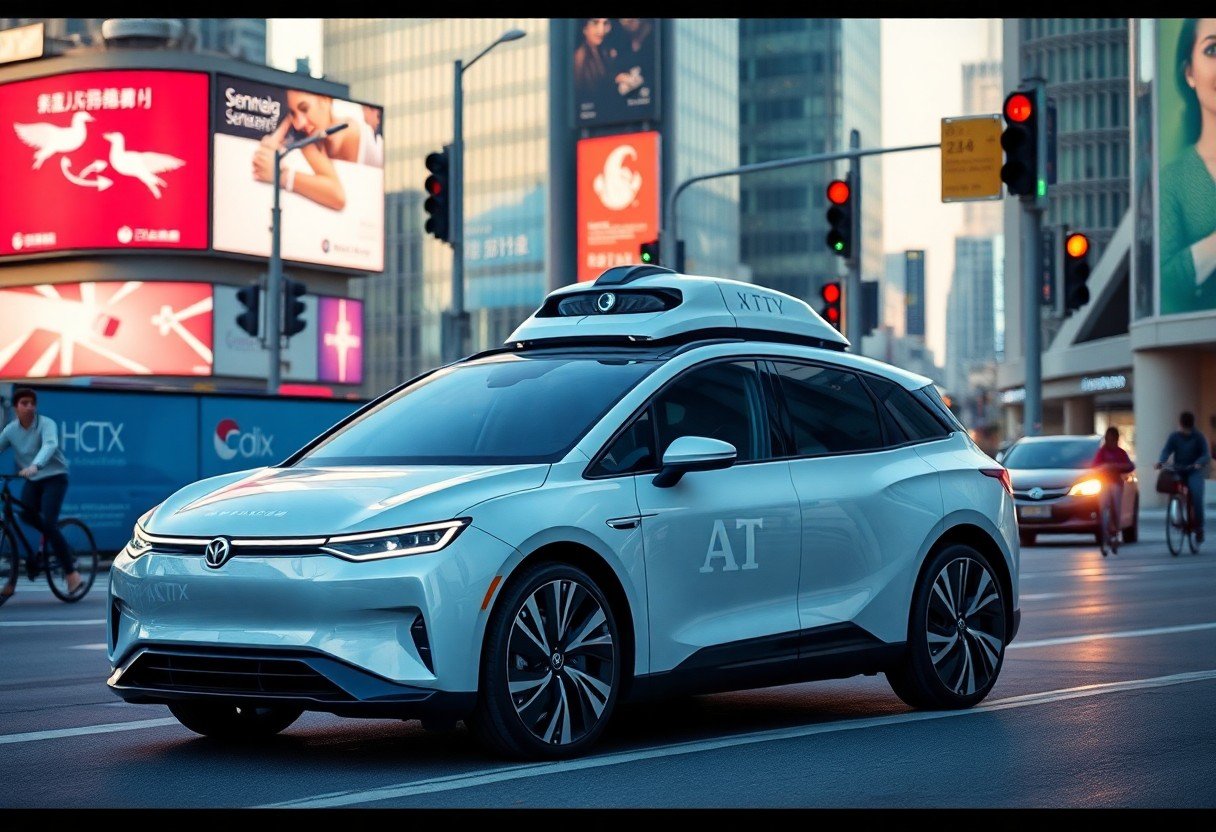Over the past few years, advancements in automotive artificial intelligence have sparked a fascinating evolution in self-driving car technology. You may be wondering how these innovations could reshape your driving experience and enhance road safety. In this blog post, we’ll explore the significant impacts of AI in the automotive industry and its role as a driving force behind the next self-driving car revolution. For more insights, check out the Impacts and Transformations of AI in the Automotive Industry.
Key Takeaways:
- Automotive AI enhances decision-making and perception systems, improving safety and efficiency in self-driving cars.
- Advancements in machine learning and neural networks are driving innovations in autonomous vehicle technology.
- Collaboration between tech companies and automotive manufacturers is vital for the rapid development and deployment of self-driving vehicles.
The AI Revolution: Transforming Traditional Automotive Engineering
Your vehicle’s design and manufacturing processes are undergoing a seismic shift due to artificial intelligence. With AI deeply embedded in engineering practices, automakers streamline workflows, optimize performance, and enhance the overall quality of vehicles. This transformation enables manufacturers to respond rapidly to consumer demands, ensuring innovative features like smart technology and connectivity are integrated seamlessly into new models.
Enhancing Vehicle Safety Through Intelligent Systems
You benefit from enhanced vehicle safety as AI systems analyze real-time data to make split-second decisions. Technologies such as adaptive cruise control, lane departure warnings, and collision detection work together to minimize risks on the road. These intelligent systems adapt to your driving style and conditions, providing a safer driving experience for all road users.
Streamlining Manufacturing with Predictive Algorithms
Predictive algorithms revolutionize manufacturing efficiency by forecasting potential equipment failures and optimizing resource allocation. By analyzing data patterns, AI tools can predict maintenance needs before breakdowns occur, reducing downtime and ensuring production flow remains uninterrupted. This proactive approach results in cost savings and a more efficient manufacturing environment.
Imagine walking into a manufacturing facility where AI algorithms predict when a machine might falter, allowing for maintenance before problems arise. By utilizing historical data and machine learning, manufacturers achieve higher productivity, cutting costs by reducing unexpected downtimes by as much as 20%. Additionally, this data-driven approach ensures a more responsive supply chain, improving inventory management and accelerating the time it takes for a vehicle to go from concept to production, keeping you ahead in a competitive market.
Navigating the Complexity: AI Algorithms in Self-Driving Technology
Self-driving technology relies on sophisticated AI algorithms that process vast amounts of data. These algorithms must discern pedestrian movements, traffic patterns, and various road conditions, providing insights that allow vehicles to navigate safely and efficiently. As detailed in the report on Self-driving cars: The next revolution, the interplay between advanced computing and real-time data is critical to achieving full autonomy.
The Role of Machine Learning in Decision-Making
Machine learning models train self-driving cars to recognize patterns and make decisions based on real-time data, drawing from historical driving experiences to improve future behavior. These systems adapt and evolve, enhancing their ability to predict possible outcomes in complex driving scenarios.
Sensor Fusion: How AI Integrates Data from Various Sources
Sensor fusion combines data from multiple sensors, such as cameras, LiDAR, and radar, creating a comprehensive understanding of the vehicle’s environment. This integration allows for more accurate perception and decision-making, vital for navigating unpredictable road conditions.
Through sensor fusion, self-driving cars can mitigate the limitations of individual sensors by cross-verifying information, increasing reliability. For instance, a vehicle might utilize data from cameras to identify road signs while simultaneously leveraging LiDAR to measure distances to nearby objects. This multi-sensor approach enhances situational awareness, enabling safer navigation, especially in complex environments like urban settings, where quick and accurate responses are paramount. Ultimately, the synergy of diverse data inputs via AI not only improves operational efficiency but also significantly boosts passenger safety.

The Ethical Dilemma: Navigating AI Decision-Making in Crisis Scenarios
Autonomous vehicles are challenged to make split-second decisions during emergencies, raising complex ethical questions. The algorithms must weigh potential harm to passengers, pedestrians, and others, often in scenarios where no choice satisfies every moral standard. How these vehicles are programmed to handle such dilemmas will greatly influence public acceptance and the future of self-driving technology.
The Morality of Algorithmic Choices: Who’s Responsible?
As AI systems make decisions, the question of accountability arises. If a self-driving car causes an accident, do you hold the manufacturer, the software developers, or the vehicle owner responsible? Defining liability in these scenarios is complex and remains largely unaddressed in legislation, leaving you to ponder who truly bears the consequences of algorithmic choices.
Public Perception and Trust Issues in Autonomous Technology
Your trust in self-driving cars heavily influences their adoption. Many people remain skeptical due to high-profile accidents and the fear of technology failing in critical situations. Building confidence in AI systems requires transparency about decision-making processes and the ethical frameworks guiding their operations.
Public concern extends beyond accidents; it encompasses the broader implications of relinquishing control to machines. According to a 2022 survey, about 60% of respondents expressed discomfort with autonomous vehicles, fearing loss of control and trust in technology. Recognizing these sentiments, developers must engage in open dialogues, demonstrate robust safety measures, and ensure that ethical considerations are at the forefront of AI development to foster a more favorable perception.
The Race to Autonomy: Key Players and Innovations Driving Change
Your understanding of the self-driving car landscape will deepen when you explore the leading companies and groundbreaking technologies shaping this evolution. Major players like Waymo, Tesla, and Cruise are investing heavily in AI systems, while fresh entrants like Aurora and Zoox introduce innovative approaches. Each is racing to harness machine learning, computer vision, and advanced sensor technologies, aiming to establish their dominance in a rapidly evolving market. With billions allocated to research and development, the quest for fully autonomous vehicles is not just a goal but a competitive necessity.
Industry Giants vs. Startups: Who’s Leading the Charge?
You’ll find an intriguing dynamic between established automotive giants and agile startups in the self-driving car sector. While industry titans leverage vast resources and experience, startups often innovate faster due to their flexible structures. Companies like General Motors and Ford are collaborating with or acquiring smaller firms to push their technologies forward. Conversely, Tesla continues to set benchmarks in software development and fleet learning, showcasing the diverse methods in which leadership is defined and demonstrated within this arena.
Partnerships and Collaborations: Shaping the Future of Self-Driving Cars
Building alliances is fundamental in the self-driving car industry. This collaborative spirit combines expertise from various fields, accelerating innovation and addressing the multifaceted challenges of autonomy. Strategic partnerships are emerging between tech firms and automotive manufacturers, like the collaboration between NVIDIA and Mercedes-Benz, focusing on AI computing. Partnerships with governmental bodies also help in navigating regulatory landscapes, as seen in cities piloting self-driving programs. Such collaborations not only enhance research capabilities but also position players favorably within evolving market dictates.
Consider the partnership between Waymo and Stellantis, which aims to integrate autonomous technology into commercial vehicles, showcasing a dual focus on passenger safety and logistics efficiency. Furthermore, collaborations with academic institutions like Stanford University accelerate research advancements, demonstrating how inter-industry cooperation leads to practical applications in autonomous systems. Each partnership you explore reveals different dimensions of industry commitment, offering valuable insights into how the future of self-driving cars is collaboratively being shaped.

The Road Ahead: Regulatory Challenges and Opportunities
Navigating the regulatory landscape is vital for the advancement of self-driving technology. You face a complex interplay of regional laws, safety standards, and public concerns that can either facilitate or hinder progress. As automakers and tech companies innovate, the need for cohesive regulations that ensure safety while promoting technological advancement becomes paramount. This balancing act presents numerous challenges and opportunities for stakeholders to engage and create frameworks that support this revolutionary change in transportation.
Crafting Legislation That Keeps Pace with Innovation
Legislation must evolve in response to rapid advancements in automotive AI. You may see lawmakers collaborating with industry experts to draft guidelines that address safety, liability, and data privacy. Proactive approaches can streamline approval processes for new technologies, encouraging innovation while ensuring consumer protection. States like California have already begun drafting policies that pave the way for more permissive testing environments, illustrating a changing landscape that adapts to the needs of developers and consumers alike.
Testing and Public Trials: The Path to Widespread Adoption
Public trials and rigorous testing are critical to gaining consumer trust and demonstrating the reliability of self-driving cars. You will find that companies often conduct tests on open roads, collecting data in real-world conditions to refine algorithms. Collaboration with local authorities to implement controlled trial programs can serve as a model for future regulatory frameworks that prioritize public safety while enabling technological growth.
Your experience with self-driving technology will shape as public trials become more prevalent. Companies like Waymo and Cruise are conducting extensive pilot programs that allow vehicles to operate under varying conditions. These trials gather invaluable real-time data, enabling engineers to tackle edge cases and improve system reliability. Engaging with the community during these trials fosters transparency, addressing public fears and helping consumers understand the benefits and limitations of autonomous vehicles. As regulatory bodies observe these trials, positive outcomes can lead to streamlined approval processes for wider deployment, ultimately paving the way for a new era in transportation.
Final Words
So, as you explore the exciting world of automotive artificial intelligence, it’s clear that this technology will play a pivotal role in shaping the future of self-driving cars. With advancements in AI, your experience behind the wheel will evolve, making driving not just safer but also more enjoyable. Embracing these innovations means you’ll be at the forefront of a transportation revolution, transforming the way you travel and interact with your vehicle.



